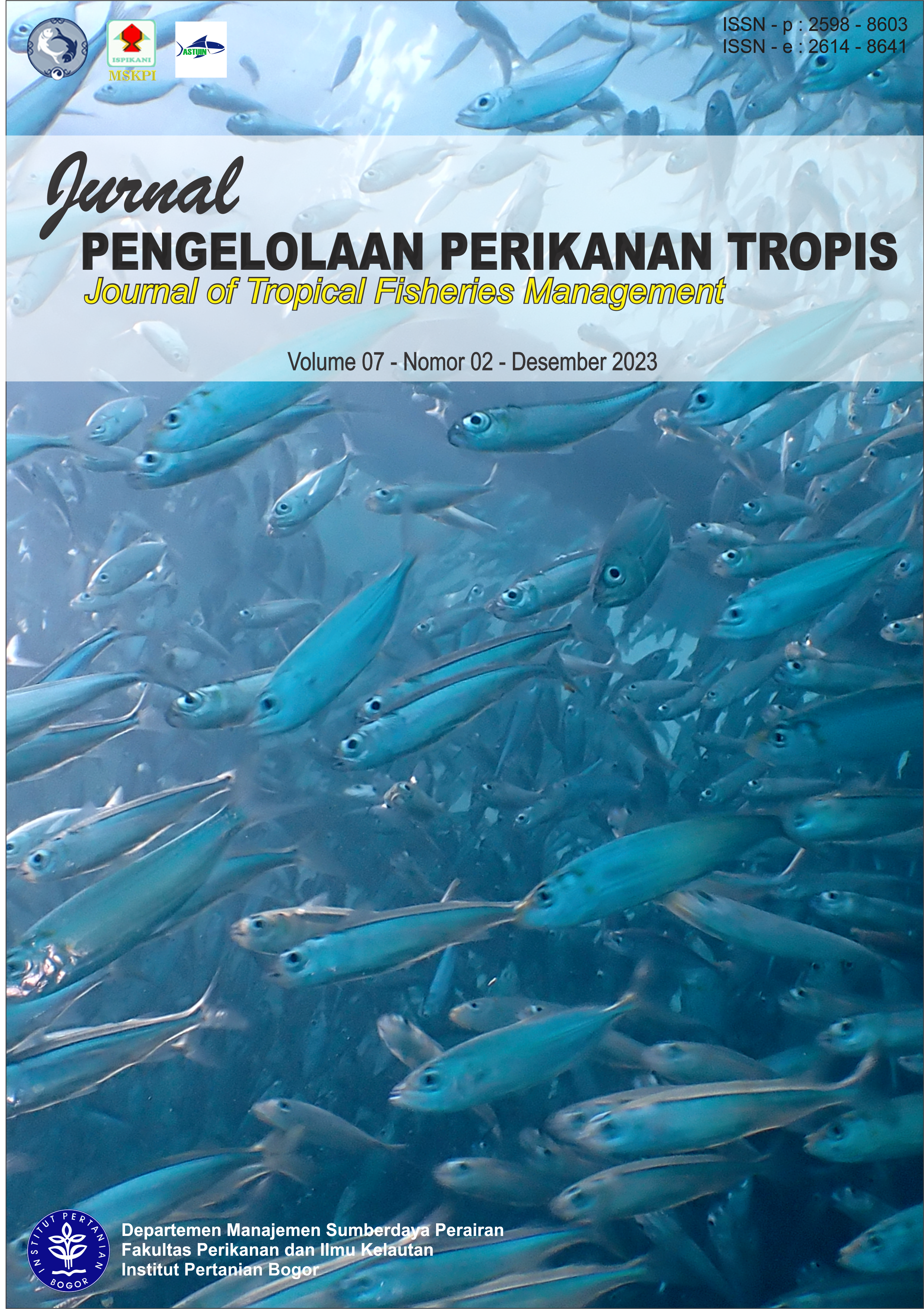Analisis Pola Pertumbuhan Ikan Ekor Kuning (Caesio cuning) Yang Didaratkan Di Kawasan Pelabuhan Ikan Muara Angke, Jakarta
Abstract
Yellowtail Fusilier (Caesio cuning) is one of the fish caught by fishermen landed in Kaliadem, which is then sold at Muara Angke Fish Market, Jakarta. (Caesio cuning) has high economic value and has been widely consumed by various circles of society. This study aims to determine the heavy relationship with morphometric variation of (Caesio cuning) to obtained fish growth pattern. The collection of 30 fish samples was carried out in April 2018 with a survey method at the Muara Angke Fish Market. Morphological observations were carried out traditionally using a ruler with 0.01 mm accuracy and weighed using analytical scales with an accuracy of 0.01 gr. The analysis used for morphometric and fish weight measurement data is multiple linear regression. The results obtained that the overall morphometric character affects fish weight by 98.4%, where the morphometric characters in the mouth length (PM) have a positive effect on fish body weight with a p-value of 0.048 and coefficients of 21.843. This figure can be assumed that every time there is an addition to the mouth length of 1cm, it will increase by 21.8gr fish body weight with category positive allometric growth pattern.
Downloads
References
Habibun, E.A., 2011. Aspek pertumbuhan dan Reproduksi Ikan Ekor Kuning (Caesio cuning) yang didaratkan di Pangkalan Pendaratan Ikan Pulau Pramuka, Kepulauan Seribu, Jakarta. Bogor (Skripsi):IPB Pr.
Harmiyati D. 2009. Analisis hasil tangkapan sumberdaya ikan ekor kuning (Caesio cuning) yang didaratkan di PPI Pulau Pramuka, Kepulauan Seribu. Bogor (Skripsi):IPB Pr.
Haryono, 2001. Variasi Morfologi dan Morfometri Ikan Dokun (Puntius lateristriga) di Sumatera. Jurnal Biota VI (3):109-116.
Jabbar MA. 2008. Pengelolaan Sumberdaya Perikanan Ekor Kuning (Caesio Cuning) di Perairan Kepulauan Seribu. Skrispsi. Sekolah Ilmu dan Teknologi Hayati, Institut Teknologi Bandung. (tidak dipublikasikan)
Mujiyanto. 2010. Hubungan Panjang Berat Caesio Cuning Hasil Tangkapan Bubu Di Perairan Saeh Nusa Tenggra Barat. Prosiding Seminar Nasional Biologi: Perspektif dalam Pengelolaan Sumberdaya Hayati. Fakultas Biologi UGM. Yogyakarta, 972-977.
Nggajo, R., Yusli W., dan Neviaty P.Z., 2009. Keterkaitan Sumberdaya Ikan Ekor Kuning (Caesio cuning) dengan Karakteristik Habitat Pada Ekosistem Terumbu Karang di Kepulauan Seribu. Jurnal Ilmu-Ilmu Perairan dan Perikanna Indonesia. 16(2):97-109.
Okgermen, H., 2005. Seasonal variation of the length weight and condition factor of Rudd (Scardinius erythrophtalmus) in Spanca Lake. International Jornal Zoological Research. 1(1):6-10.
Pratiwi S.U., 2017. Rasio Potensi Pemijahan Ikan Ekor Kuning (Caesio cuning) sebagai Input Pengelolaan Perikanan Tagkap di Perairan Karimunjawa. Bogor (Skripsi):IPB Pr.
Prihatiningsih, Isa N.E., dan Bambang S., 2018. Biologi Reproduksi, Pertumbuhan dan Mortalitas Ikan Ekor Kuning (Caesio cuning Bloch, 1791) di Perairan Natuna. BAWAL, 10(1):1-15.
Subroto I.H, Subani W., 1994. Relasi Panjang Berat, Faktor Kondisi dan Pertama Kali Matang Gonad Ikan Ekor Kuning dari Perairan Banggai Kepulauan. Jurnal Penelitian Perkanan Laut. (91). Jakarta:Balai Penelitian Laut Departemen Pertanian.
Umar, H., 1999. Riset Strategi Perusahaan. Penerbit PT. Gramedia Pustaka Utama. Jakarta.
Walpole, RE., 1995. Pengantar Statistika, Edisi ke-3. PT. Gramedia Pustaka Utama. Jakarta.
Copyright (c) 2024 Journal of Tropical Fisheries Management

This work is licensed under a Creative Commons Attribution 4.0 International License.
After the article is submitted and published in this journal, it is fully copyrighted by the Journal of Tropical Fisheries Management. If excerpts from other copyrighted works are included, authors must obtain written permission from the copyright owner and give credit to the source in the article. Then, authors or reader is allowed to copy, share, and redistribute articles/material in any form. But it must still include the appropriate source and credit because the article in this journal is licensed by Creative Commons Attribution 4.0 International License (CC BY 4.0).




1.png)








